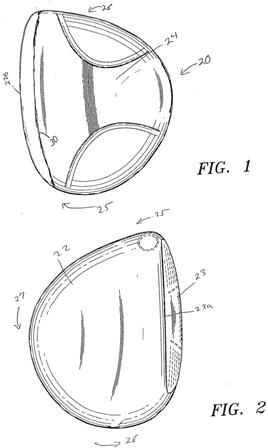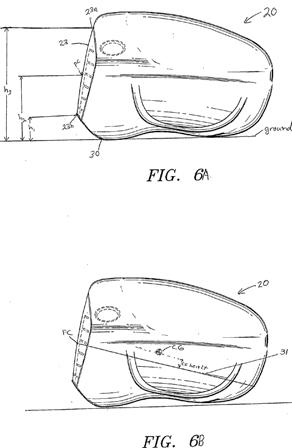Say What; Expecting a Tour Striker and Find a Callaway Driver!
This morning I was browsing through the newly published golf-related patent applications and came across one titled “Golf Club Head with Elevated Face.” I though “ahh, must be that Tour Striker practice club that I see advertised all over the place.” Boy was I surprised after a few clicks when I realized that it was a Callaway driver! Check this out:
[0009] The face has a first height, h1, measured from the ground to the bottom of the face, a second height, h2, measured from the ground to the center of the face and a third height, h3, measured from the ground to the top of the face, when a golf club is at address.
[0010] The first height, h1 is at least 0.3 inch above the ground when the golf club head is at address. The golf club head has a volume ranging from 400 cubic centimeters to 470 cubic centimeters, a moment of inertia, Izz, about the center of gravity of the golf club head greater than 5000 grams-centimeters squared, and a moment of inertia, Iyy, above the center of gravity of the club head greater than 3500 grams-centimeters squared.
[0011] The ratio of h2/h3 is at least, if not greater than, 0.57 and the height of the center of gravity is at least, if not greater than, 0.060 inch relative to the face center normal. The measurement of h1 is preferably more than 0.3 inch when a golf club is at address at a lie angle of sixty degrees and a face angle of zero degree.
[0012] One aspect of the present invention is a driver type golf club head. The golf club head includes a body with an elevated face. The body has a crown portion, a front wall having a perimeter and a sole portion. The body also has a heel wall, a toe wall and a rear wall. The heel wall extends 4.0 inches to 5.0 inches rearward from the perimeter of the front wall and the rear wall is substantially perpendicular to the heel wall. The toe wall is substantially perpendicular to the rear wall, and the toe wall extends from 4.0 inches to 5.0 inches from the rear edge of the toe wall. The face on the front wall has a first height, h1, measured from the ground to the bottom of the face, a second height, h2, measured from the ground to the center of the face and a third height, h3, measured from the ground to the top of the face. When then the golf club head is at address with a lie angle of 60 degrees and a face angle 0 degrees, h1 is at least 0.3 inch above the ground. Preferably, the ratio of h2/h3 is at least, if not greater than, 0.57. The height of the center of gravity is at least, if not greater than, 0.060 inch relative to the face center normal. The golf club head has a volume ranging from 400 cubic centimeters to 470 cubic centimeters, a moment of inertia, Izz, about the center of gravity of the golf club head greater than 5000 grams-centimeters squared, and a moment of inertia, Iyy, above the center of gravity of the club head greater than 3500 grams-centimeters square.
[0013] A second aspect of the present invention is a golf club head. The golf club head has a body having a face wall, a crown wall, a sole wall, a heel wall, a rear wall, and a toe wall. The face wall has an approximately rectangular shape and the face wall has a variable thickness. The golf club head has a volume ranging from 400 cubic centimeters to 470 cubic centimeters, a moment of inertia about the Izz axis through the center of gravity of the golf club head which is greater than 5000 grams-centimeters squared, and a moment of inertia, Iyy, above the center of gravity of the club head greater than 3500 grams-centimeters squared. The face wall has a first height, h1, measured from the ground to the bottom of the face, a second height, h2, measured from the ground to the center of the face and a third height, h3, measured from the ground to the top of the face, when then the golf club head is at address. When the golf club is at address at a lie angle of preferably sixty degrees and a face angle of zero degree, h1 is at least 0.3 inch above the ground. The height of the center of gravity is at least, if not greater than, 0.060 inch relative to the face center normal. The ratio of h2/h3 is at least, if not greater than, 0.57.
[0014] Another aspect of the present invention is a golf club head. The golf club head has a face component composed of a metal material. The face component has a striking plate portion and a return portion. Coupled to the return potion of the face component is a substantially square aft-body. The length of the face component coupled to the aft-body ranges from 4 inches to 5 inches. The striking plate portion has a first height, h1, measured from the ground to the bottom of the face, a second height, h2, measured from the ground to the center of the face and a third height, h3, measured from the ground to the top of the face, when a golf club is at address. When the golf club is at address at a lie angle of sixty degrees and a face angle of zero degree, h1 is at least 0.3 inch above the ground. The ratio of h2/h3 is at least, if not greater than, 0.57. The golf club head has a volume ranging from 400 cubic centimeters to 470 cubic centimeters, a moment of inertia, Izz, about the center of gravity of the golf club head greater than 5000 grams-centimeters squared, a moment of inertia, Iyy, above the center of gravity of the golf club head greater than 3500 grams-centimeters squared. The height of the center of gravity is at least, if not greater than, 0.060 inch relative to the face center normal.
That is some pretty interesting hypothesizin’!
Dave Dawsey – The Golf Intellectual Property Attorney
PS – click here to check out other driver and wood design posts


